
The Union at Stratford Middle: Preparing Students for Success in High School
The last two years of middle school are crucial in preparing students for the greater responsibility and academic rigor of high school. If students fall behind in seventh or eight grade, they have that much more to catch up before being ready for college or career. Many never do.
The Martha O’Bryan Center’s Academic Student Union at Stratford Middle is working to fill this need and engage students before they enter high school.
In the fall of 2016, in partnership with Metro Nashville Public Schools and Stratford STEM Magnet Middle School, The Union was designed specifically for 7th and 8th grade students to help them prepare for success in high school.
The Union offers after-school programming five days a week to assist with homework, tutoring, and enrichment opportunities. In addition to this programming, The Union also has a full-time Middle School Transition Coach who provides support to 8th grade students. The Coach helps them set personal and academic goals and then continues to meet with these students throughout their first semester of 9th grade at Stratford High School.
The Scarlett Family Foundation has provided funding for The Union at Stratford Middle since it first began in 2016. This program has been successful, with 50% of 7th and 8th grade students at Stratford Middle participating in The Union in its first 3 years.
Once entering high school, students have the opportunity to connect into the O’Bryan Center’s “Top Floor,” an academic student union serving high school students— creating a seamless pathway of support from middle to high school.
Tags: Grantee Story

Stuck in Sinking Sand on the Pathway to Graduation
Following Nashville Students’ Educational Journeys
Through the release of our Metro Nashville Public Schools (MNPS) Cluster Profiles, the Scarlett Family Foundation hoped to share data in a clear, concise format, and use this information to help tackle some of our city’s most pressing education questions, including: what happens to proficiency levels as students progress through their zoned schools?
In our last blog post, we zeroed in on another critical question: are Nashville students graduating ready for college or career? And we drew the conclusion, based on the data available to us, that an overwhelming majority of students are not graduating ready for their next step. But is this exclusively a high school problem? In order to paint a full picture of our student achievement deficits, we decided to take a deeper look into the pathway MNPS students will take toward graduation, beginning in their earliest school-going years.
In schooling, grades act as stepping stones, connecting one level of academic understanding to the next. Each grade creates different opportunities for students to be curious, explore their world, and leave prepared for the next step awaiting them. But when we look at cluster-level data, we find that student access to quality public education, and the opportunities found therein, look drastically different depending on where a student lives.
In too many neighborhoods, the pathway to graduation is like sinking sand, pulling students deeper into a broken system of low-performing schools— at every consecutive stage of their education.
All students deserve easy access to high-quality, public schools. But in Nashville, this is not a reality.
To see how starkly different a student’s school journey will look based upon his or her address, let’s compare two school clusters: Hillwood and Maplewood.
Elementary School
If a student lives in the Hillwood cluster, she will be zoned to attend one of four elementary schools. Two of these are Reward schools (ranking in the top 5% of all Tennessee schools), and another far exceeds state average proficiency levels for both English Language Arts and Math (58% and 50% achieving proficiency, respectively). On average, less than 1% of the elementary school students in this cluster have been suspended, only 11% are chronically absent (missing 10% of the school year, or 18 days), and teachers choose to remain in their positions by a rate of 92%. Looking at these metrics alone, it appears that families in this neighborhood have access to elementary schools able to provide their children a high-quality education.
In the Maplewood cluster, a student will also be zoned to attend one of four elementary schools, depending on where exactly he lives. One of these schools is a Reward school – but one is a Priority school, ranking in the bottom 5% of all schools in Tennessee. Only 17% of all elementary students in the Maplewood cluster are proficient in English Language Arts, and 15% in Math. On average, close to 4% of elementary students are suspended annually, 23% are chronically absent, and almost 16% of teachers are new to the job each year.
Let’s imagine that a family in the Maplewood cluster is considering enrolling their student at Tom Joy Elementary. A Priority school, only 5% of Tom Joy’s 421 students are proficient in English Language Arts, and the rate is even lower for Math. Unless this family has the ability to enroll their child in a charter or private school, their only elementary school option is a school that fails to bring 95% of its students to proficiency. This is a disservice to the family and to the child.
The metrics presented in our Cluster profiles make clear that a scenario like this is the reality for countless Nashville families, and illustrate that even in elementary school, a majority of MNPS students are already being left behind.
Middle School
The degree to which student achievement lags behind grade level standards only grows from elementary to middle school.
The Maplewood cluster is home to two zoned middle schools – and both rank in the bottom 5% of schools statewide. Across the cluster, enrollment drops from elementary to middle school, and nearly 17% of students will either be suspended or chronically absent from school. The two-year rate of educators who do not return to teach in these schools is 20% . Taken together, these challenges affect the ability of teachers to teach and students to learn: only 6% of middle school students in the Maplewood cluster are proficient in English Language Arts, and less than 5% are proficient in Math.
Hillwood also has two middle schools, but in this case, both exceed the MNPS average for proficiency in English Language Arts and Math. Proficiency rates for students in English Language Arts is 29, and 26% in Math. However, like the Maplewood cluster, enrollment drops from elementary to middle, and the percentage of students who are suspended or chronically absent nearly doubles.
If we compare the two clusters, Hillwood’s middle schools are performing well – but let’s flip some numbers. If roughly 30% of students are proficient in ELA or Math, that means at least 70% of Hillwood students are not achieving proficiency. Imagine the effect this will have on our students as they enter high school, and eventually a college classroom or professional workplace.
As we comb through these numbers, a trend emerges. In all clusters, academic achievement sinks as we follow the pathway of elementary to middle to high school. It seems that students progress from one grade to the next without gaining the academic knowledge they will need to flourish in the future.
High School
As students in the Hillwood cluster transition from middle to high school, even more of them will miss at least 10% of all school days— now, one in five students is chronically absent. Consequently, English and Math proficiency numbers also decline. Although the vast majority of students in this cluster will graduate, a much smaller number will score a 21 or higher on the ACT, indicating that they should be considered college and career ready — only one in four, or about 265 students.
In the Maplewood cluster, we see an even more significant spike in empty seats during the school day, with 42% of students chronically missing school. The number of students “On Track” dips below 5% in both English or Math, and only around 41 students are considered college or career ready upon graduation. Still, just as in the case of Hillwood High School, most of these students will receive a high school diploma.
What’s Next?
Unless dramatic improvement is made, a student in the Maplewood cluster will attend a school ranking in the bottom five percent statewide for every year of their education.
For a student in the Hillwood cluster, the academic experience is likely to be better— but far from exceptional. From elementary to high school, the percentage of students that are considered “On Track” continues to slide lower at each step, until only 17% (ELA) and 7.2% Math) of students are learning what they need.
Incredibly, the graduation rates between these two high schools, Hillwood (81%) and Maplewood (79%), are almost the same— with only a 2% difference.
These numbers demand a city-wide conversation. Let’s decide, finally, that zip code will not be destiny for Nashville students.
It’s time for all members of our community to band together and push for transformative change. We must create a system that allows all high school graduates to succeed after graduation, no matter which post-grad pathway they choose. And when we say all students, we mean all— from Hillwood to Maplewood.
Read more about ways you can get involved and make change here.
Tags: MNPS Cluster Profiles

The Next Step: Students Graduate, But Are Not Ready
By Tara Scarlett
A shorter version of this piece originally ran in the Tennessean. https://www.tennessean.com/story/opinion/2019/04/26/nashville-students-graduating-high-school-unprepared/3554911002/
Next month, Metro Nashville Public Schools (MNPS) will celebrate another graduating class with pomp and circumstance. They will bestow upon our high school seniors a diploma, a mutually understood signal that these students are ready to forge ahead to college or the workforce.
In reality, most of them are not.
The 2017-2018 Tennessee Department of Education report card shows that 80% of our students graduated high school on time. However, this same report also shows that 3 out of 4 MNPS students did not score a 21 or higher on the ACT, which is the state’s marker for– and a widely accepted indicator of– college and career readiness.
The situation becomes even more dire when we realize that the state assessment indicates 89% of our high school students are not proficient in grade level math; and 81% are not proficient in grade level English Language Arts.
These averages only scratch the surface. When we dive deeper into the data on specific MNPS high schools, as the Scarlett Family Foundation has done, we see rates of chronic absenteeism (students missing more than 10 days) as high as 30, 40, even 47 percent. We see that almost every student zoned for Whites Creek High will attend a priority school (a school measuring in the bottom 5 percent statewide for student growth) for every year of their education. And we find that in eight out of the twelve traditional MNPS high schools, the average ACT score is below 18.
These numbers demand a city-wide conversation.
Whether that conversation takes place between a student and a teacher, teacher and a principal, a teacher and a parent, or a parent and their child, the data we have available to us can start a transformative discussion on what is needed to support every child’s education.
At the Scarlett Family Foundation, the heart of our work is a four-year college scholarship awarded annually to students who graduate from a high school in Middle Tennessee and will major in Business or a STEM field. The practice of reading these applications year after year gives us a deeper understanding of who our Middle Tennessee students are.
This year, we were tasked with selecting finalists from a pool of almost 2,000 applicants. This required hours of careful— and sometimes painful— consideration.
Many of these students blow us away with their smarts, drive, passion, and dedication to the community. But far too often, we see applicants at the top of their class, earning GPAs of 4.0 or even higher, with ACT scores that are several points below a college or career-ready score of 21. How is this possible?
In the essay section, applicants’ responses are often riddled with spelling and grammatical errors, and lack basic coherence, structure, and message. It is unlikely that these students will be able to write at the level expected in an institution of higher education or in a workplace.
Yet, every May, MNPS says to our students: you are ready for the world. Take it on! Make things happen! And year after year, MNPS hand over a new round of diplomas, even as our community is confronted with data that tells us only 25% of these students are actually ready for the next step. We tell our students they are prepared for post-grad success while simultaneously ignoring the warning signs we can see clearly in front of us.
Who does this willful ignorance serve? The reality is that the other 75% of MNPS students will likely struggle to find and keep a job that pays a living wage, or will spend their first year at a college or university in remedial courses.
Imagine the disappointment, discouragement, and heartbreak these students will have to stomach when they realize that 13 or 14 years in our public school system did not actually prepare them for a prosperous adulthood.
This is an injustice to our children. So, what can you do?
We all have different levels of capacity in this fight. But if you feel outraged by the state of our schools, there are many ways to plug in and make a difference.
- Share the data and the stories. Nashville needs more people to get involved in helping to turn around our schools. This is an undertaking that serves all of our kids – no matter if you live on the Westside, Northside, Eastside or Southside. Every single child in Nashville deserves access to a high-quality school.
- Raise your voice in front of your elected officials. Demand a triage plan to help students who are in school today. We are witnessing a public education system in crisis, beginning with early childhood education and continuing through to adulthood. Be vocal.
- Volunteer your time to address root issues. To be most successful in their academic futures, children need to be reading at grade level by third grade. Become a mentor to a high school student, or read to 20 minutes a day to a child who needs it. Today, only 25% of our third graders have mastered or are on track to mastery in English Language Arts, and math proficiency is even worse.
- Support great principal and teacher talent development by advocating for increased professional development and practice sharing in the teaching community. See the Tennessee State Board of Education’s ranking of top programs for aspiring educators.
Whether you are ready to be a boots-on-the-ground problem solver, or prefer to play the role of an outside advocate, Nashville needs you.
We cannot keep turning a blind eye. Instead, let’s band together and push for transformative change that will allow all high school graduates to succeed after graduation, whatever pathway they choose. The children of Nashville deserve this— and our city is worth it.
Tara Scarlett is President & CEO of the Scarlett Family Foundation.
Tags: MNPS Cluster Profiles

A City on the Move. Students Left Behind.
Our city is growing at a breakneck pace. Consider the constant headlines on new industry setting up shop in Nashville: Amazon, E&Y, Philips, and Alliance Bernstein are committed. Oracle is in talks. And we can’t ignore the boost in tourism brought by the NFL Draft, the Predators reaching for the Stanley Cup, and a continual stream of talented musicians showcasing their songs. Music City is booming. As we stare this new economic landscape in the face, we must acknowledge that our growth is outpacing our ability to provide homegrown talent to the local workforce. It has never been more important to focus on Nashville’s K-12 public education system.
From a district-level perspective, we can see immediately that something is wrong. Three out of four of third graders aren’t reading on grade level. Almost 20% of students are chronically absent from school (missing 10% or 18 school days). And three out of four MNPS high school students did not score a 21 or higher on the ACT, a widely accepted indicator of college and career readiness. Our public education system, the foundation of our community, is crumbling. The benefits of the economic boom in Nashville are not extending to all residents — particularly our MNPS students.
In order to tell the whole story, we realized we needed to zoom in, to see in greater detail how specific schools and neighborhoods are performing— to see how Hillsboro compares to Antioch, and how Whites Creek stacks up to McGavock.
The critical question is: are students ready for life when they graduate from high school?
One way to tell is to look at each “cluster” of schools.
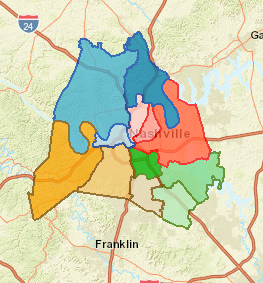
MNPS is divided into 12 clusters, or zones, with all elementary and middle schools feeding into one high school per zone. Students are zoned to their cluster of schools according to their address, and will follow a zoned pathway from elementary to middle to high school. Families in Nashville do have choice, though, meaning they can opt to apply to a magnet school, non-zoned school or public charter school even if the school is not in their assigned zone.
There is so much data to explore; and that is why this is only the first in a series of blogs that will unpack the information found in our MNPS Cluster Profiles. In future pieces, we will be looking closely at the readiness of high school graduates, district enrollment trends, and teacher retention, among other topics.
Lowest-Performing Schools concentrated in three neighborhoods
The number of priority schools (schools ranked in the bottom 5% statewide) in Nashville has increased in the last three years— to 21 total. As we look at the location of these schools, we see that they are largely concentrated in three neighborhood zones: Whites Creek, Maplewood and Hunters Lane.
Students in these three zones are likely to attend not just one, but two or even three priority schools during their K-12 years. If dramatic improvement is not made, a majority of students in the Whites Creek cluster will attend a school in the bottom five% statewide for every year of their education.
Great schools, but not in every neighborhood
Similarly, our city’s highest achieving schools are concentrated in just a few neighborhoods. Hillsboro, Hillwood and Overton zones have the highest performing high, middle and elementary schools. Many of the traditional schools that meet or exceed the state averages for English and Math achievement are located within these three neighborhoods.
Another significant observation: of our 22 Reward schools (schools recognized by the state for making gains in student growth and achievement), only nine of them are actually within the traditional cluster pathways— one, LEAD Cameron Middle, is a charter school. Six of them are non-zoned MNPS schools and have additional admission requirements (such as academic magnets). Another seven are non-zoned charter schools. These public charter schools practice open enrollment, allowing for any Nashville student to enroll regardless of home address.
As we begin to piece these data together, we quickly realize that access to the best schools is limited. Unless families choose to attend a high-performing charter school, students either need to live in the “right” zone, or gain acceptance to an academic magnet school.
Enrollment drain in every neighborhood
Every single MNPS cluster experiences a large student enrollment drop-off from elementary to middle school. The size of the drops ranges widely, from 40% at McGavock and Hunters Lane to 59% at Maplewood, but the trend is consistent. MNPS middle schools have far fewer students enrolled than do their feeder elementary schools.
It is an unfortunate reality that Nashville families are often forced to look outside of their neighborhood schools in order to provide their children a high-quality education. But the numbers prove that many parents are making that choice.
Nashville graduates not ready
If we track those students who do follow their zoned school pathway from the start of their K-12 career to the finish, we see the number of students classified as “On Track” or “Mastered” in English and Math proficiency slide downward from elementary school to middle school, and from middle to high school.
- Not one high school has an average ACT score of 21 (the minimum score considered college or career ready)
- Eight of the twelve high schools have average scores below 18, with five scoring 16 or below.
- At eight high schools, fewer than one in ten students are “On Track” or “Mastered” for both English and Math.
Yet MNPS graduation rates hold steady at about 80%.
Year after year, MNPS bestows upon our high school seniors a diploma, a mutually understood signal that these students are ready to forge ahead to college or the workforce. But many of them are not actually prepared for the next step.
The consequence of regularly passing students who are not grade-level proficient from one level to the next is clear: our graduates fail to meet the demands of college or the workforce. We see this plainly in college completion rates. According to a recent report by the Nashville Public Education Fund, only one in four MNPS graduates actually completes a degree after leaving the district.
A crisis in chronic absenteeism
In addition to proficiency deficits, Nashville’s high schools are also facing a chronic absenteeism crisis. A third, and in some cases more, of MNPS high school students are missing at least 18 days of school per year.
- At Stratford STEM, almost half of students miss 18 or more days of school.
- Maplewood and Whites Creek have absentee levels above 40%.
- Four more schools are at or above 30% (Antioch, Pearl Cohn, Hunters Lane, & Glencliff).
These data help to put our student achievement shortfall in context; if students are not in the classroom, our educators cannot teach them.
Bright spots of strong success
Although there are shortcomings that must be acknowledged, MNPS schools also give us reasons to be encouraged.
Each of the following schools operates within the most challenging MNPS zones— and has demonstrated remarkable achievement and growth.
- Shwab Elementary (Maplewood) is a reward school for 2018.
- Joelton (Whites Creek) shows student achievement at 40%, four times that of neighboring schools.
- Dan Mills (Stratford) presents low chronic absenteeism numbers and student achievement over 50%.
- LEAD Cameron was recognized as a Reward school for the second year in a row. This school serves as the zoned middle school option for students in the Glencliff cluster.
It is true that data only tell one side of the story, and that the context for these numbers can vary widely from school to school, classroom to classroom. But by diving into these numbers, we are able to illuminate the parts of our public school system that are working well, and to put a critical spotlight on the areas that desperately need improvement. With this goal in mind, we will continue to highlight our top data-driven takeaways in a series of blog posts to be released over the coming weeks.
We hope to present school data in a way that feels accessible to all members of our community, from parents to principals, employees to CEOs. We believe that when all Nashvillians can have an informed conversation about our public education system, innovation and improvements will follow. Together, we can take steps to ensure that every child in Nashville receives a high-quality public education and is prepared for success after graduation.
Please check back for more on our blog series on the MNPS Cluster Profiles.
Tags: MNPS Cluster Profiles
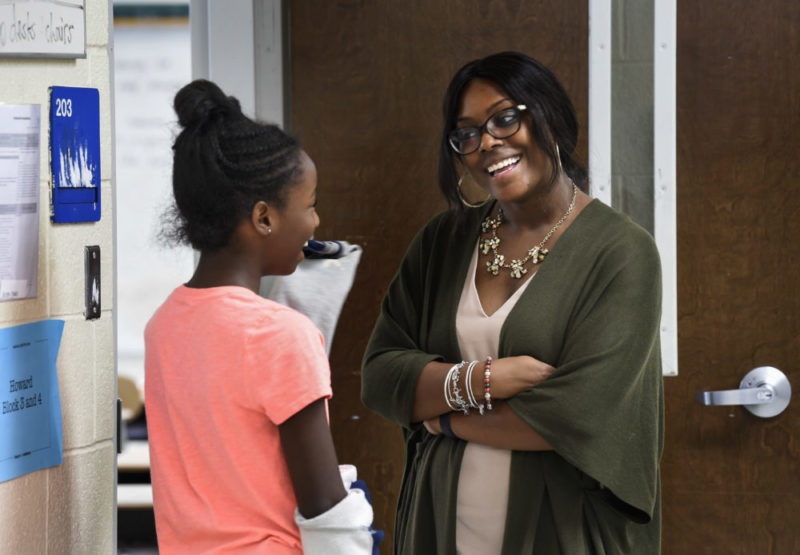
Teach for America Nashville: Building a pipeline of teachers and leaders
Teach For America (TFA) seeks and supports an outstanding and diverse network of leaders who commit to expanding educational opportunities for all children. By recruiting high-achieving, passionate college graduates into Nashville classrooms, TFA bolsters the teacher candidate pool and builds a pipeline of local leaders to expand educational opportunity for children facing the challenges of high-need school communities.
TFA partners with Metro Nashville Public School (MNPS) and supplies nearly 70-90 teachers to the city each year. TFA and MNPS work together to combat the local teacher shortage throughout the school year and even into the summer. Through MNPS summer programs and camps, TFA teachers help students with credit recovery, remediation and enrichment opportunities.

On the 2018 Tennessee State Board of Education Teacher Preparation Report Card, TFA was one of eight teacher preparation programs to receive a top ranking.
The Scarlett Family Foundation provides funding to TFA in order to allow more students to have access to great teachers every year. With a current corps member and alumni network of 1,000 teachers and leaders in the Nashville area, TFA also cultivates a group of advocates determined to see that every child has access to a high-quality education.
Through its focus on high quality teachers, effective school leaders, equal access to summer learning, and education policy experts who are energized to advocate for all students, TFA helps Nashville students reach their fullest potential in high school, college, and beyond.

What We’re Learning: Nashville’s Charter Schools
At the Scarlett Family Foundation, we believe all students should be able to attend a high-quality school that meets their needs. Charter schools seek to empower families with that choice— regardless of their zip code or ability to pay private school tuition.
If we want to see all Nashville students have access to a great education, we need more high quality schools, regardless of type. True school choice only exists when there are many good options for parents to choose from, along with clear, accessible information about those options.
But the current reality in Nashville is that we are too far from this goal. Over the last six years, more Nashville schools have fallen into the state’s bottom five percent. We are moving in the wrong direction. As we look to change course, we must find out what is working— and what’s not. And in order to make that judgment, we need quality information from both charter and traditional schools.
That’s why the Scarlett Foundation has sought to provide clear, understandable information about all Metro Nashville Public Schools through our website. Our Charter School one-pagers show key metrics for each school. View them here.
Key insights about charter schools serving Nashville:
In the 2017-2018 school year, Nashville’s thirty-one charter schools served almost 12,000 students— 14% of Metro Nashville’s total student population (up from 12% the previous year). Of the thirty-one charter schools operating in Nashville in the 2017-2018 school year, nine are elementary, seventeen middle, and five high school.

Almost all of these schools practice open enrollment, meaning any family may apply to enroll their child there. The exceptions to this are LEAD Cameron, LEAD Brick Church and LEAD Neely’s Bend, which are all zoned options for their district cluster. Brick Church and Neely’s Bend are also Nashville’s only two schools currently being operated by the statewide Achievement School District.
Demographically, charters serve a more diverse student population with a larger percentage of Hispanic and African American students than traditional public schools. Charters also serve a slightly smaller percentage of English Language Learners and students with disabilities, but a larger percentage of economically disadvantaged students.
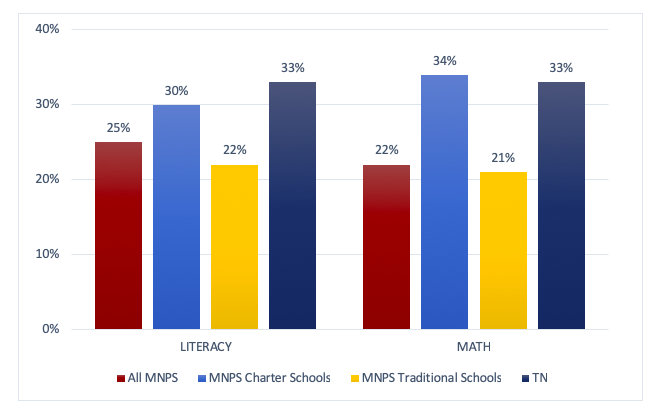
In measures of student achievement, charter schools score higher on average than traditional public schools. 30% of students at charter schools scored “on track or mastered” in ELA and 34% in math, compared to 22% and 21% in traditional public schools.
A marked difference between charter schools and traditional public schools is revealed in the state’s measurement of student growth. As a district, MNPS scored a Level 1, the lowest on the TVAAS metric. But 18 charter schools — over half of the number operating in Nashville— scored a Level 4 or 5. This means the students at these schools are growing academically faster than their peers across the state. But this growth is more consistent in elementary and middle schools:
- Of the six elementary schools that have a growth score, four scored a Level 4 or 5 and two scored a Level 1.
- Of the seventeen charter middle schools in Nashville, twelve of them scored Level 5; one school scored a Level 4, one a Level 3 and three scored a Level 1.
- Of the five charter high schools, only LEAD Academy scored a Level 5, while STEM Prep scored a Level 3 and KIPP, Knowledge Academies and Republic High Schools scored a Level 1.
Looking at school culture, there are mixed results. Nashville’s charter schools have lower average chronic absenteeism and lower student attrition than Metro’s traditional public schools, but also have higher average suspension rates.
Other Key Takeaways:
By diving deeper into the data, we can better understand how charter elementary and middle school academic achievement compares to their traditional peer schools.
At MNPS traditional elementary schools, 28% of students scored on track or mastered for both ELA and math. At middle schools, only 20% of students scored on track or mastered for ELA, and 15% for math. Here’s how charter schools stack up in comparison:
- The two highest achieving charter elementary schools almost doubled the district’s overall student achievement. Purpose Prep had 57% of students achieve on track or mastered for ELA and 65% for math; Nashville Classical had 49% and 55% respectively.
- The two charter elementary schools with the lowest performance were Rocketship Nashville Northeast (17% ELA and 12% math) and KIPP Kirkpatrick Elementary (11% ELA and 26% math).
- The two highest achieving charter middle schools are both Valor Schools. Valor Flagship had 66% of students score on track or mastered on ELA and 75% on math; and Valor Voyager had 48% and 59% respectively.
- Aside from Nashville’s two ASD schools, the two lowest performing schools in academic achievement were Knowledge Academy at the Crossings (15% ELA and 9% math) and Knowledge Academy (16% ELA and 15% math).
- We only have key “ready graduate” data available for one charter high school, LEAD Academy. According to the state metric, 35% of LEAD Academy graduates qualified as “ready” while the overall rate of readiness in all MNPS schools (traditional, charter and magnet) was 24%.

Oasis College Connection: Helping more students enroll and succeed in college
For too many Nashville high school students, college seems a distant possibility— or worse, an unattainable dream. But the ability to reach and complete post-secondary education opportunities can be a critical factor in exiting the cycle of poverty.
Recognizing this reality, the Oasis Center formed the Oasis College Connection (OCC) in 2008. This intensive, college-counseling program provides individualized admissions and financial aid expertise to Nashville area students and their families.
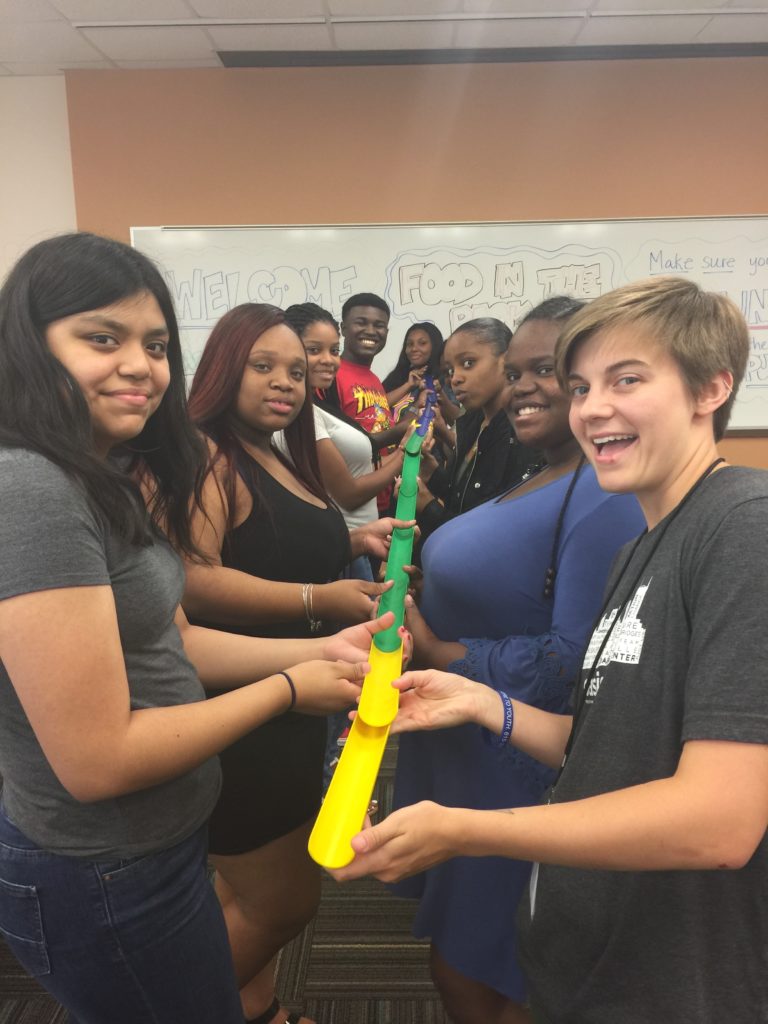
At OCC, students connect with a mentor who is responsible for supporting them throughout the college enrollment process. The Center offers ACT prep and FAFSA assistance, as well as opportunities to talk with college representatives and visit college campuses. Most importantly, the OCC helps counsel students on their search for a college or program that will suit their needs and interests best, setting them up for a better chance to be successful in completing their degree. Even after students have graduated high school and entered their post-secondary programs, OCC mentors will continue to offer them guidance and support as they navigate their education journey.
The Scarlett Family Foundation has provided funding for Oasis College Connection since 2008, inspired by the belief that all students deserve access to resources that will allow them to become college ready. Through their school-based model, OCC has worked with over 5,000 Metro Nashville Public School (MNPS) students in 10 high schools, their feeder middle schools, and Nashville State Community College.
In order to provide the best resources for students, Oasis College Connection works in close partnership with MNPS, both inside and outside of the classroom. This provides ample opportunity to discuss college access in group settings and to host personalized one-on-one meetings. Teachers and school leaders are true partners to the College Connection mentors, each group collaborating with the others to teach students that tomorrow is as important as today.

Growing Prosperity by Furthering College & Career Readiness
Earlier this year, Governor Bill Haslam shared what has motivated his administration’s tireless work on behalf of students, “I do believe in, as much as possible, trying to level the starting line, and the best way to level the starting line is education.” This thought succinctly encompasses the mission our state has set forth: to provide all Tennessee students with a clear, attainable pathway to economic prosperity through education. Not only does a well-educated workforce benefit our state as a whole, but it also ensures that year by year, more Tennesseans will have the ability to support themselves and their families through quality jobs.
Over the last decade, Tennessee has taken bold, purposeful steps to improve the quality of education students are receiving and to support their overall success. After years of progress– and with a change in state leadership forthcoming—we must set our sights on the path ahead, as our next steps will be some of the most important yet. To do that, we need to remember where we have been and evaluate what challenges still lie ahead.
High Expectations and Accountability Laid the Foundation
In 2007, Tennessee received failing marks from the US Chamber of Commerce for “truth in advertising” related to student proficiency results. This became a galvanizing moment for our state, a chance to raise expectations around education in our communities. Tennesseans came together to create and adopt rigorous K-12 standards and addressed tough issues like mandatory assessments and teacher evaluations.
By implementing high standards— and holding our teachers, schools, and students accountable to them— Tennessee has become one of the fastest improving states in the nation and stands out among our Southern peers for student growth.
Although there is much work still to be done, Tennessee has laid a formidable foundation to improve student outcomes and to increase the number of well-prepared students sent on to college and career pathways. We cannot continue this improvement unless we maintain our commitment to high standards and the continual assessment of student learning.
Post-Secondary Education Opportunities are Key to Economic Success
While 87 percent of high school students say they want to go to college, 34 percent of Tennessee’s students forgo higher education to enter the workforce immediately after high school. Without any post-secondary training, these students can expect an annual salary of $10,880— not nearly enough to live on or to raise a family. It is also important to note that at least 55 percent of jobs in our state will require some form of higher education credential by 2025.
All students deserve a bright future, a life that includes a steady job and a living wage, no matter the path they choose to take after high school. For this reason, the stakes are high for our students. The question is no longer, “How do we get students to graduation day?”; but “How can we ensure high school is an on-ramp to college and career?”
Next Step: Building a College-Going Culture
Tennessee is implementing innovative programs and approaches to increase readiness and to create seamless pathways from K-12 to postsecondary certificate or degree attainment after high school.
- As a state, we have set a goal to improve participation rates and performance on the ACT, a key metric of high school students’ college readiness. In 2018, more Tennessee students took the test than ever before and scores are improving.
- Through the Tennessee Promise and Reconnect programs, now any Tennessean has the opportunity to attend two years of community or technical college tuition-free. As a result, our state leads the nation in FAFSA applications; and postsecondary enrollment is up.
- Early Post-Secondary Opportunities and Career and Technical Education programs at our high schools are helping to give students more exposure to potential postsecondary options and equip them with the tools and skills they need to be successful on their chosen path.
- The Seamless Alignment and Integrated Learning Support (SAILS) Program has helped thousands of students get face-to-face instruction time in high school to catch them up and avoid remedial coursework in college. Since launching statewide in 2013, the program reduced the percentage of students needing math remediation by 15 percent.
- The Labor and Education Alignment Program (LEAP) brings together business and education to identify and address high-need skills gaps in a region. LEAP grants created opportunity for students to participate in dual enrollment, work-based learning and career exploration programs for high-demand jobs.
Through the programs above, Tennessee is redefining what it means to go to college. By offering students both financial and educational support, our state is ensuring that Tennessee students have more onramp opportunities for postsecondary education and then stay on track to complete a degree or credential. Technical colleges, community colleges, certification programs and 4-year universities are all producing the certifications, degrees and credentials that the workforce of today and tomorrow will require; our students should view each of these options as a powerful pathway to prosperity.
What’s next?
Tennessee will welcome new state leadership in the coming year. Our new governor, in tandem with our state legislators, will have a prime opportunity to shape education policy in ways that will have lasting impact on our workforce and economy. These leaders should focus on accelerating our progress by building upon education policies and reforms that have been shown to work, and finding innovative solutions to persistent challenges.
Over the past decade, we have witnessed the ways in which our students can benefit when elected officials from both parties join forces with education, business and community leaders. If we encourage the leaders of our state to dedicate themselves to expanding the programs that are working well, enabling more students to exit K-12 well-prepared for their next steps in life, we could forever change what it means to live and work in Tennessee.
Read More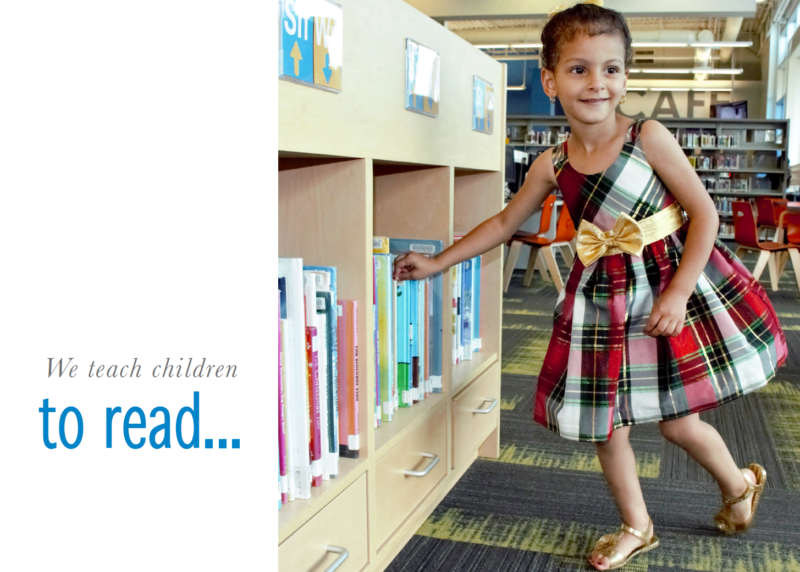
Nashville Adult Literacy Council: Teaching children to read, by teaching parents to read
In the Blueprint for Early Childhood Success, a citywide framework to improve Nashville’s literacy rates, the words “parent,” “family(ies),” and “generation” are mentioned more than 300 times. The Blueprint’s research and recommendations indicate that parental engagement is critical for childhood success. However, such support is practically impossible for parents who can’t read or who lack English-speaking skills.
The Nashville Public Library estimates that 250,000 Nashvillians need adult education support, like basic literacy, high school equivalency, and English. As a city, we are serving just one percent. Adult literacy rates impact every part of Nashville: employment and poverty levels, healthcare costs, K-12 school performance, and general dependence on systems for support.
The Nashville Adult Literacy Council (NALC)’s vision is for all Nashville adults to attain the literacy skills they need to navigate life and support their children. NALC learners become more independent and confident through improved health, financial security, and family and community engagement.

NALC learners like Amany know that parental engagement is critical for the success of children like Marlee.
NALC’s mission is to teach reading, writing, and English-speaking skills to Nashville adults. Since 2008, the Foundation has supported the Start Now tutoring program at the Antioch branch. Their services provide learners with a safe place to learn and grow, primarily through one-on-one tutoring, supported by a network of dedicated volunteers. The nonprofit efficiently coordinates with partners and ensures students find the best options for their goals so they can feel the difference in their day-to-day lives.
Whether it’s working toward a new job, earning a degree, or helping a child with homework, NALC values and prioritizes each individual’s learning needs. In short, NALC teaches children how to read by teaching parents how to read.
Read More
Metro Nashville School Board District Profiles: Good data empowers parents, advocates and local leaders
Even while a lot of media and attention is paid to state and Federal races this election season, public engagement in local school board elections is just as important.
School board members have a major impact on education in Nashville, and this election will set the direction for Metro Nashville Public Schools (MNPS) and the 85,000+ students it serves.
On August 2, along with the statewide primaries, Nashville will vote on four of the nine school board seats— Districts 2, 4, 6, and 8.
Board members serve a four-year term and act as the primary oversight of our public schools, make key decisions about academic strategies, and develop the annual operating budget. They have a big influence in how taxpayer funding is allocated to schools, classrooms and special services. The Board also has oversight authority over the District Superintendent and reviews charter school applications.
While voters should certainly learn about candidates for the Metro Nashville school board, they should also learn about the school district, the students served, and the teachers and principals it seeks to attract and retain.
Because some education data is hard to track down or spread out across different state and district sources, we compiled key metrics to empower local voters with the right data for sound-decision making.
Our goal in providing this data is to equip our community with good information as we work together to ensure every child receives a high-quality education.
Key Insights about Metro Nashville Public Schools
 Demographically, MNPS is unique for a few reasons. Twenty percent of the student population qualify as English Language Learners— four times the state number. Additionally, half of the students are economically disadvantaged, compared to 35 percent statewide.
Demographically, MNPS is unique for a few reasons. Twenty percent of the student population qualify as English Language Learners— four times the state number. Additionally, half of the students are economically disadvantaged, compared to 35 percent statewide.
Of the 85k-plus students served by MNPS, about 12 percent attend charter schools, which are independently run public schools that have increased flexibility in exchange for greater accountability. Charters serve demographically-similar student populations as MNPS traditional schools do but with a slightly larger percentage of economically disadvantaged students.
When looking at student and school culture data, some concerning trends emerge. MNPS has high chronic absenteeism, with 17 percent of students missing a tenth or more of a school year. This means almost one in five students are missing a large chunk of instruction every year.
Recruiting and retaining great teachers and school leaders is also a known challenge— and the most recent data affirms it. The teacher retention rate for the 2017-2018 school year was 76 percent for MNPS traditional schools and 75 percent for charters. And the average principal has served in their role for only four years.
Finally, while MNPS lags behind the state in student achievement, there is a difference in achievement levels for different types of schools. When comparing traditional MNPS schools to charter schools, charters show near equivalent or higher achievement scores and surpass the state in growth scores.
Digging Into the School Board District Data
In addition to MNPS data, we have compiled key achievement, student culture and teacher data by School Board district. You can download the district profiles for the 2016-2017 school year here to see detailed breakdowns for each.
Here are a few key takeaways:
- Districts 1, 3 and 7 have the lowest percentages of students qualifying as “college ready” in MNPS (7%, 11%, and 15% respectively).
- District 2’s student population is so diverse it has no racial or ethnic majority, and its charter schools have the highest achievement and growth scores in MNPS.
- District 4 has the longest average for years a principal has served in the role, but is still only 4.9 years. District 8 has the shortest average for years a principal has served at 2.6 years.
- District 5 serves more students than any other district. It has the highest percentage of students in charter schools and the highest district growth score in MNPS.
- District 6 serves the second largest student population and is home to three newly-founded charter high schools (one in 2015 and two in 2017).
- District 7 has the highest percentage of ELLs in MNPS and the second lowest cumulative growth score.
- Districts 8 and 9 have the smallest student populations and lowest percentages of economically disadvantaged students; while they have higher than average district achievement data and percentages of “college ready” students, growth scores are lower.
Find the full District Profiles here.
Read More

